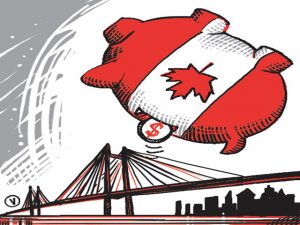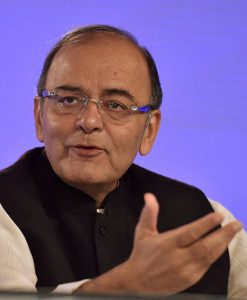
19-10-2016 (Important News Clippings)
To Download Click Here
‘Political parties have built an edifice of democracy, but their foundations remain undemocratic’
While the Central Information Commission (CIC) has been arguing for bringing political parties under the ambit of the Right to Information (RTI) Act, all political parties and the central government have consistently opposed this demand. Association for Democratic Reforms (ADR) has spearheaded this fight, which it argues will usher in transparency in public life. Its founder member Jagdeep Chhokar told IP Singh why all major national political parties remain opposed:
Despite their sharp ideological differences all the six national parties – Congress, BJP, BSP, CPI, CPM and NCP – argued before CIC that they were not covered under RTI. CIC, however, held that they were public authorities. Now, the central government has argued on similar lines in the Supreme Court while responding to our PIL for implementation of the CIC’s order.
Are some parties more transparent than others?
Some parties claim to be more democratic but the net result is the same. One party claims to work by ‘democratic centralism’. I fail to understand what that is and how it strengthens internal democracy in a party. Lack of internal democracy and transparency in parties is blocking demonstrable democracy in the country.The appointment of chief ministers is not happening through a democratic election by MLAs but through a farce in the name of election after central observers hold a meeting. They are selected by the high command. So where is actual democracy? Political parties have built an edifice of democracy but their foundations remain undemocratic.
AAP is headed by Arvind Kejriwal, who received the Ramon Magsaysay Award for his contribution to the RTI movement. Do you find a difference in AAP’s approach?
AAP has not appointed a public information authority to the best of my knowledge. Frankly, i have no expectations from any political party. Nothing will happen unless they are forced to bring changes in their working and become more open to public scrutiny. Political parties have the same approach when it comes to lack of fundamental belief in demonstrable democracy in the working of their parties. AAP doesn’t seem any different.
Like candidates, should political parties also have spending limits in elections?
We are pursuing a petition in the Delhi high court, praying for a limit for parties too. We are pleading for: a limit for parties; that they should start filing details of expenses one year before election and that they should file details of expenses after every two to three days after elections are announced so that people can make sense of their expenses. Currently, they provide details 75 days after a government is formed. At that point, who remembers the finer details of their activities during campaigning? Suppose a chief minister travels by chopper and addresses six rallies in a day, let the people know how much was spent.
Many feel that real expenditure is several times higher than the cap.
The current limit has been decided by the government, not by the Election Commission. We have hard data to show that candidates claim to spend less than the limit. Out of the 6,753 candidates of the 2009 Lok Sabha elections that we scrutinised, only four admitted that they had exceeded the limit while 30 said they had spent 90%. The rest claimed that they spent 52-55%. But, we generally hear that the limit should be increased. The data and the argument against the limit are contrary to each other. It is anybody’s guess where the truth lies. Apparently, there is a lot of unaccounted money in elections.The late Gopinath Munde had admitted that he incurred Rs 8 crore expenditure in his Parliament election. A Rajya Sabha member from Haryana claimed that one needs to spend Rs 100 crore. About Rs 4 crore was stolen from the office of a political party in Delhi and it did not even lodge a complaint. So, parties have good reason for not wanting to disclose information about their working.
Is the political system solely responsible for corruption?
The political system is the fountainhead of corruption. Politicians say that big donors are not ready to donate through cheques while representatives of big companies argue that they want to pay through cheques but politicians want cash.
Date: 19-10-16
Retreat by Moscow?
With old ally no longer looking out for India, it must redo its strategic math
India’s diplomatic drive to isolate Pakistan encountered a determined Chinese block at the Goa Brics summit, and the bad news from New Delhi’s point of view is that old ally Russia is more in China’s corner than India’s on this one. Thus the Brics summit declaration specifically mentioned terror groups that are of interest to Russia and China, such as Islamic State and Jabhat al-Nusra, but overlooked Pakistan-backed terror groups that are of interest to India. There are other straws in the wind, such as joint Russia-Pakistan military exercises. Moreover, Russia is effectively doing a Pakistan to Ukraine by fuelling an ethnicity-based proxy war there. Faced with a furious Western backlash Russia is entering China’s orbit, presenting a challenge to Indian diplomacy.New Delhi must recognise that in international relations, interests and realpolitik calculations count for far more than ideology. Pakistan’s advantage is that it realised this long back. That is why it can leverage support from both China and America, otherwise strategic competitors. It has used this to, in effect, get America to bail it out of sticky financial situations, then pay China to build its infrastructure. China’s diplomatic support for Pakistan is payback for the economic opportunities it provides.
For India to change the game it must, first of all, persuade the Americans of the number of ways they are being had, that current US policy towards Pakistan is counterproductive. If the US can be dissuaded from being Pakistan’s financial benefactor, let us see if China wants to assume responsibility for Pakistan’s debt. The decks can be further stacked by offering China more economic opportunities in India. This can be done by offering connectivity to China’s One Belt, One Road project which Beijing is currently pursuing as its route to growth.
A route through India would provide the Chinese what they seek – access to the Arabian Sea – while building India’s infrastructure and diminishing the importance of CPEC and Gwadar port. If incentives alone do not work New Delhi can build in some disincentives as well. One could be denial of market access if China continues to support terror groups. Second, India could consider doing to China what China has helped Pakistan do to India: work on battlefield tactical nukes to be deployed on the Chinese border.
Canadian maple syrup for our infrastructure

Large infrastructure players are hamstrung by stalled projects and heavy debt. The government should swiftly roll out the bankruptcy code to resolve bad loans. Project costs need to be scaled down and existing promoters and bankers should take haircuts. As today’s lead article points out, realistic costs, detailed planning and timely implementation of projects are a must to avert cost and time overruns.
States, which are responsible for many clearances, must improve the regulatory framework. Raising corporate governance and credible reporting standards also hold the key to making India an attraction for investors. The biggest drawback in India’s infrastructure funding model so far has been that it has been largely financed by banks that mostly hold short-term cash but lend for long-term projects. Result: growing asset-liability mismatch. However, banks are really not meant to play a role in the long-term market. India needs to develop a market ring-fenced according to maturity.Funds raised for, say, 15 years should finance projects of a similar tenure. Indian insurers and pension funds must find it easier to invest in long-term debt. The way ahead is to create a vibrant corporate bond market, with insurers and pension funds playing a major role.
आठ सिद्घांतों के दम पर बेहतर होगा नियमन
आशा यह की गई थी कि नियामकों के गठन के बाद केंद्रीय नियोजन का मुकाबला किया जा सकेगा लेकिन इस दिशा में समुचित सफलता हाथ नहीं लग सकी है। विस्तार से बता रहे हैं अजय शाह
Date: 19-10-16
ब्रिक्स की प्रासंगिकता?
गोवा में पिछले सप्ताह आयोजित ब्राजील, रूस, भारत, चीन और दक्षिण अफ्रीका के संगठन ब्रिक्स का सम्मेलन निराशाजनक नतीजों के साथ संपन्न हुआ। ब्रिक्स सदस्यों द्वारा भविष्य में अपने मतभेद दूर करने की उम्मीद को किनारे रख दें तो इस दो दिवसीय सम्मेलन में कोई ठोस नतीजा हासिल नहीं हुआ और सिर्फ आतंकवाद से लेकर शहरीकरण और जलवायु परिवर्तन जैसे विभिन्न मसलों पर महज जबानी जमाखर्च हुआ। अधिकांश समय तो इन्हीं उपदेशों में बीत गया कि ब्रिक्स सदस्यों को कैसे एक साथ आना चाहिए और एक दूसरे को लाभ पहुंचाना चाहिए।
Court orders and reluctant governments
Court orders, such as the Supreme Court’s in the Cauvery case, will be obeyed only if responsibility is fixed on specified officers of the government
“In a Government of laws, existence of the Government will be imperilled if it fails to observe the law scrupulously…(G)overnment is the potent and omnipotent teacher. For good or for ill, it teaches the whole people by its example… if the Government becomes a law breaker it breeds contempt for the law; it invites every man (or woman) to become a law unto himself (or herself); it invites anarchy.” — Justice Louis Brandeis of the U.S. Supreme Court in Olmstead et al v. United States, 1928.
The initial obstinate reluctance of the Karnataka government to comply with successive orders of the Supreme Court relating to the Cauvery river water dispute and later its resentful compliance exposes one of the confounding fault lines of constitutional governance. What is a court to do when governments dig in their heels and refuse to comply with its orders? Though in the Cauvery water dispute case, the looming disaster of the breakdown of constitutional machinery sticks out like a sore thumb, it is unfortunately not a sole aberration but symptomatic of a larger malaise that is growing every day. Courts are increasingly flooded with contempt petitions against the government/state authorities for wilful disobedience of orders of courts with no prospects of the deluge abating in the near future.
Fixing accountability
Court orders have the impelling force of rule of law and foundational constitutional values that governments must respect in order to preserve the ever fragile fabric of constitutional democracy. However, given the stark reality of increasing hostility to court orders, either belligerent or subdued, how are courts to deal with such situations within the framework that the law affords them?The answer would well be that first, courts must realise that so long as they look at the government as an amorphous body of unspecified and unspecifiable individuals, we are never ever going to find a solution to this problem. Any redemption from the current situation is possible only if personal responsibility for obedience/disobedience of court orders is fixed on specified officers or individuals in government, political or bureaucratic.
Increasingly we find that systems within the nation are unable to find agreed solutions to vexatious problems within their own fold. Society is unable to decide what its reaction should be to homosexuality; religious groups are unable to find solutions within their fold even with respect to disputes relating to faith; science is unable to find solutions to disputes about what constitutes scientific evidence to uphold a particular claim; varied claims such as these come knocking at the doors of courts. What these contestants before courts must realise is that once an argument is decided by a court of law, then that particular argument gets replaced by judicial fiat. And unless it is appropriately modified in a manner known to law, the court’s fiat must be implicitly obeyed.
The First Law Commission constituted after coming into force of the Constitution observed, “It is now increasingly necessary to abandon the lingering fiction of a legally indivisible state, and a federal conception of the crown, and to substitute for it the Principle of legal liability where the state, either directly or through incorporated public authorities, engages in activities of a commercial, industrial or managerial character. The proper test is not an impractical distinction between government and nongovernmental function but the nature and form of the activities in question.”
Recalling and applying this principle, the Supreme Court in Lucknow Development Authority (LDA) v. M.K.Gupta (1993) held, “Public authorities acting in violation of constitutional or statutory provisions oppressively are accountable for their behaviour before authorities created under the Statute like the commission or courts entrusted with the responsibility of maintaining the rule of law.” In that case the Supreme Court directed the LDA to pay compensation to the aggrieved consumer and further directed that the amount must be recovered from the officer responsible for the default who must be identified. Proceeding on similar lines the Supreme Court has recently fined the Health Minister of the Delhi government Rs.25,000 for not complying with its orders.
The directions of the Supreme Court in the Cauvery river water dispute will be obeyed only if responsibility is fixed on specified officers — political or bureaucratic — of the government for complying with the orders. Adequate protection may be provided to such officers or officers from the Central government may be appointed with court directions to assist in the compliance of court orders. However, mere court fiats without fixing responsibilities for compliance can never produce the desired results in such sensitive matters. Governments will proceed to disobey them, impervious to the wise caution of Justice Brandeis, little realising that in doing so they would be sowing the seeds of anarchy.
N.L. Rajah is a senior advocate of the Madras High Court.
हक का सवाल

सहमति और दरार

रविवार को उन्होंने कहा कि भारत के पड़ोस में एक देश है जो आतंकवाद का स्रोत है और यह आतंकवाद सिर्फ भारत के लिए नहीं, सारी दुनिया के लिए खतरा है, और इसलिए ब्रिक्स को एक स्वर से इसके खिलाफ आवाज उठानी चाहिए। ब्रिक्स ने आवाज उठाई भी, जैसा कि गोवा घोषणापत्र से जाहिर है, पर इस सहमति की सीमा है। घोषणापत्र पर बारीकी से गौर करें तो दरारें दिख जाती हैं। मसलन, चीन के राष्ट्रपति शी जिनपिंग ने अपने संबोधन में आतंकवाद पर चिंता जताने के साथ-साथ यह भी कहा कि क्षेत्रीय उपद्रवों का राजनीतिक समाधान तलाशा जाना चाहिए। क्या यह बिना नाम लिये कश्मीर की तरफ इशारा था? गोवा घोषणापत्र में अंतरराष्ट्रीय आतंकवाद का भी जिक्र है और इस्लामिक स्टेट, अलकायदा तथा सीरिया के जुभात अल-नुसरा जैसे आतंकी संगठनों का भी, लेकिन न तो कहीं लश्कर-ए-तैयबा का उल्लेख है न जैश-ए-मोहम्मद का। बल्कि जैश के सरगना मसूद अजहर को प्रतिबंधित करने के भारत के प्रस्ताव को हाल में चीन दो बार पलीता लगा चुका है।
रूस से भारत की मित्रता पुरानी है, पर अब इसमें पहले जैसी प्रगाढ़ता नहीं, जिसका अंदाजा पिछले दिनों पाकिस्तान और रूस के साझा सैन्य अभ्यास से भी लगाया जा सकता है। अलबत्ता रूस के राष्ट्रपति पुतिन ने इशारों में भी वैसा कुछ नहीं कहा जैसा चीन के राष्ट्रपति ने कहा, पर उन्होंने पाकिस्तान की नाराजगी मोल लेने से बचने की सावधानी भी बरती। ब्रिक्स भले पांच देशों का समूह है और सभी बड़ी अर्थव्यवस्था वाले देश हैं, मगर इस बार सारी दुनिया की नजर भारत, चीन और रूस पर ही थी। मोदी सरकार के कूटनीतिक उत्साह के चलते यह पहले से अनुमान था कि आतंकवाद इस बार ब्रिक्स का खास मुद्दा होगा। वैसा हुआ भी। लेकिन सीधे पाकिस्तान को घेरने की रणनीति में मोदी को शी का साथ नहीं मिला। बल्कि आतंकवाद को लेकर कई जगह दोनों नेताओं के बयानों के निहितार्थ विरोधाभासी थे। यही नहीं, ब्रिक्स के गोवा सम्मेलन का समापन होते ही, चीन के विदेश मंत्रालय ने एक बयान जारी कर यह भी कह दिया कि हालांकि उनका देश हर तरह के आतंकवाद के खिलाफ है, पर वह किसी देश या धर्म को आतंकवाद से जोड़े जाने के भी खिलाफ है। और यही नहीं, इस बयान में यह भी कहा गया है कि पाकिस्तान ने खुद आतंकवाद से लड़ने में कुर्बानियां दी हैं और वह चीन का सदाबहार दोस्त है। सतह पर बनी सहमति में दरार को उजागर करने के लिए और क्या कसर बाकी रह जाती है!





